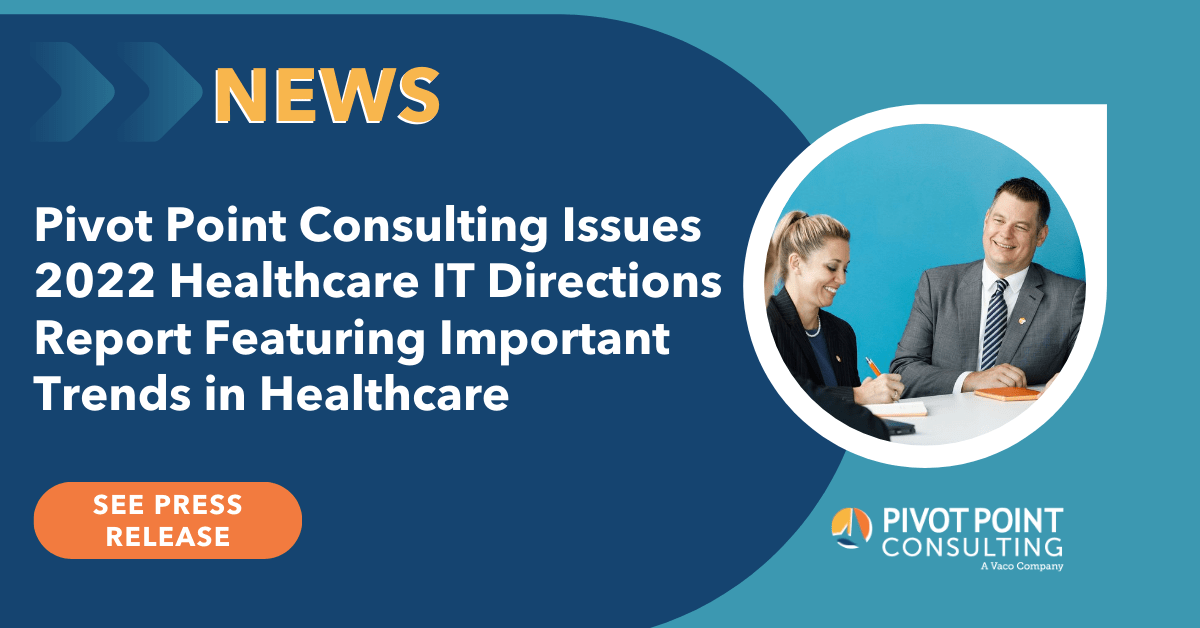NASHVILLE, Tenn., Jan. 11, 2022 — Pivot Point Consulting, a Vaco Company and #1 Best in KLAS Overall IT Services Firm (2020), today released its first Healthcare IT Directions Report, underscoring four trends certain to drive health IT decisions in 2022.
Pivot Point Consulting’s team of experts studied and identified four trends at the top of their list for 2022 including The Great Resignation, Virtual and Remote Care, Transforming Public Health Infrastructure, and The Retail Health Revolution. As the COVID-19 pandemic continues to impact healthcare and our country, health IT leaders should prepare for changing workforce dynamics, expanding modalities of virtual care, the transformative effect of investment of public health infrastructure and omni-channel competition.
The 2022 Healthcare IT Directions Report provides insights and recommendations to help leaders frame strategies, drive innovation and operate efficiently in an unpredictable, rapidly evolving environment.
The Great Resignation:
Nearly 1 in 5 healthcare workers have quit their jobs since February 2020. Among those who have kept their jobs in the healthcare field, 31% of them have considered leaving, and nearly 80% of healthcare workers’ places of work have been affected by the national worker shortage.
- Analysis: The impact of the Great Resignation on healthcare is widespread and still not fully understood. Healthcare leaders, including those in information technology (IT), are challenged with the new talent market.
- Takeaway: Organizations should evaluate and use hybrid staffing and Managed Services to establish fixed operating costs and reduce staffing risks.
Virtual and Remote Care
The pandemic accelerated the adoption of telehealth and virtual care services with research indicating the telehealth market size will reach nearly $556 billion by 2027. Beyond telehealth, approximately 200 health systems have adopted the CMS Hospital at Home model for acute care to date, a recent study revealed approximately 20% of hospitals and health clinics are currently using RPM and 43% say they believe that RPM adoption will be on par with in–patient monitoring in five years.
- Analysis: When determining 2022 virtual care investments, health IT leaders must understand the broad scope of potential services and technologies, patient demand for various types of services, differences in patient populations, and access enablers (as well as limiters).
- Takeaway: To establish strongholds in the virtual care space, healthcare organizations should market services to a broader geographic footprint, investment in solutions to further unify virtual care and embed it into delivery models, integrate and visualize telehealth and RPM data, build a dedicated RPM program, and reduce the barriers to care.
Transforming Public Health Infrastructure
COVID-19 has shifted how we perceive and receive care, increased staff burnout, made remote work a possibility for millions and fostered rapid, broad innovation in solutions and services. The pandemic also sheds light on the nation’s fragile public health infrastructure and is helping secure much-needed funding and transformation.
- Analysis: The evolving Build Back Better Act allocates significant funds for public health to expand the country’s social safety, with significant funds directed towards public health.
- Takeaway: The impact of investment and transformation of our Public Health System will be pervasive – from increasing and easing data access and reporting to shifts in career opportunities across the private and public sectors.
The Retail Health Revolution
It started in 2016-17 with Walgreens and CVS deploying Epic to thousands of care sites. Amazon took center stage in 2020-21 with bold moves in telemedicine and patient wearables, along with plans for rapid expansion of physical clinics across major metro areas. In September 2021, Walmart announced it would deploy Epic to 4,000 sites by 2029.
- Analysis: The deployment of EHRs in retail sites and increasing accessibility to and interoperability of data will continue to fuel the retail revolution at a pace that will compromise traditional healthcare providers as strongholds in many communities.
- Takeaway: Organizations should double down digital strategy and services and offer a frictionless end-to-end patient experience that will be a differentiator and competitive advantage over the convenience of retail healthcare.
“The ongoing pandemic presents lingering obstacles and monumental shifts for providers, payers, and patients, including the fundamental change to health IT. The market needs solutions,” said Rachel Marano, Pivot Point Consulting Managing Partner and Co-Founder. “With a volatile health IT labor market, permanent demand for digital and consumer-focused care, and evolving public health infrastructure, health IT leaders need a game plan to navigate and succeed in 2022. I look forward to sharing our experts’ research and guidance to help IT leaders frame strategies, drive innovation and operate efficiently in an unpredictable, rapidly evolving environment.”
About Pivot Point Consulting
Pivot Point Consulting, 2020 #1 Best in KLAS: Overall IT Services Firm, enables healthcare organizations to realize the most value from their technology and resources through EHR, ERP, Strategy, Virtual Care, Data Analytics, Cybersecurity, Service Desk, Application Support and Revenue Cycle Management services. Our experts deliver consulting, managed services and talent solutions to providers, payers, life sciences and technology organizations.


